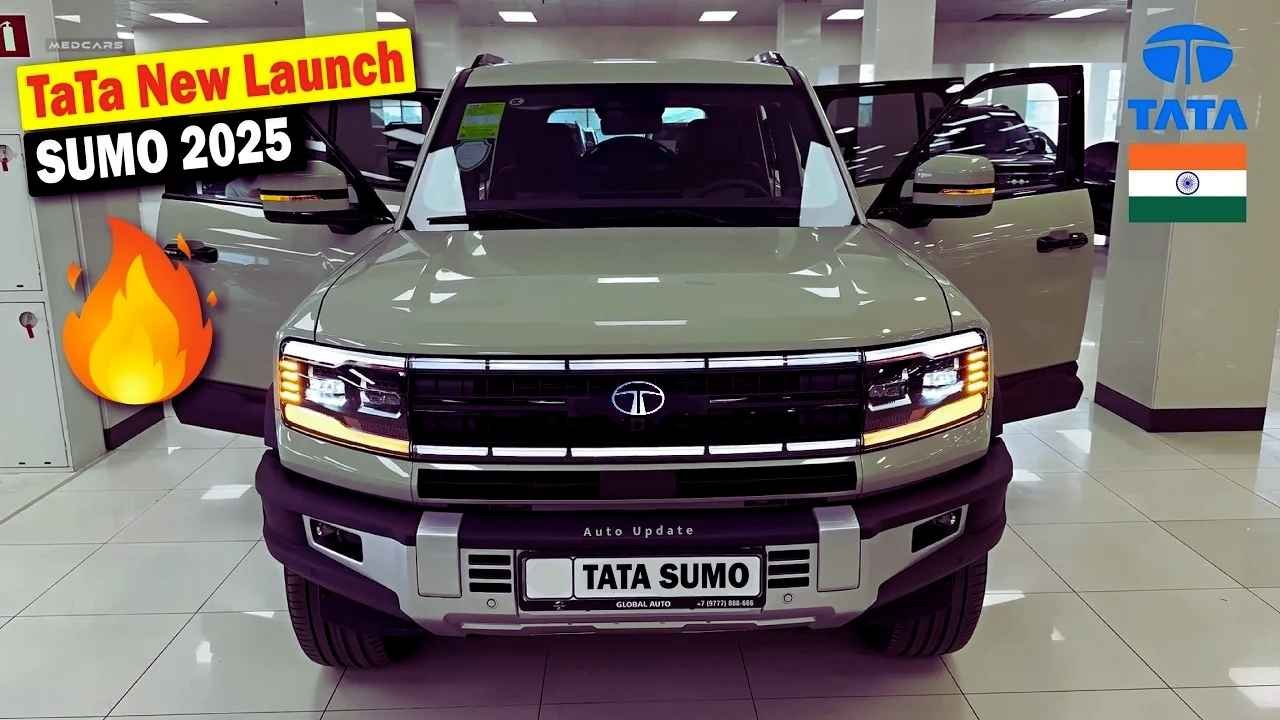A Revival That’s Got Everyone Talking
The Tata Sumo, once a go-to vehicle for its durability and spaciousness, is fueling excitement with rumors of a 2025 return. Unlike the recently launched Hero Splendor Plus XTEC 2025 or Jawa 42 Bobber, this is still speculation, with no official nod from Tata Motors. Social media and online forums are buzzing with anticipation, envisioning a rugged SUV that marries classic toughness with modern style. Here’s a breakdown of what a new Sumo might offer, crafted for fans eager for its return.
Is a 2025 Launch on the Horizon?
Tata Motors remains tight-lipped about a Sumo 2025. Some websites predict a debut at the Bharat Mobility Expo 2025 or a rollout by 2026, with price guesses ranging from ₹6.5 lakh to ₹20 lakh and odd claims like a 595cc engine producing 250 bhp (likely a typo, as SUVs demand larger engines). More realistic estimates suggest a late 2025 unveiling, hitting showrooms in 2026, targeting families, taxi operators, and rural drivers. The Sumo’s revival is less certain than the Tata Nano 2025 rumors, which also leaned on unconfirmed EV hopes.
What Could It Cost?
If the Sumo 2025 launches, expect a starting price of ₹9.5–11 lakh (ex-showroom), with top variants reaching ₹15–17 lakh. Claims of ₹6–7 lakh seem unrealistic given inflation since the Sumo Gold’s ₹5.81–8.97 lakh era. Positioned between the Tata Punch (₹6.63 lakh on-road) and Safari (₹19.29 lakh), it would rival the Mahindra Bolero Neo (₹9.50 lakh) and Scorpio Classic (₹13.62 lakh). Financing options or government incentives could make it more accessible, appealing to those eyeing affordable SUVs.
Classic Look with a Modern Twist
The Sumo 2025 might sport a bold, boxy design reminiscent of its 1994 roots, updated with Tata’s IMPACT 3.0 styling seen in the Harrier. Imagine sleek LED headlights, a prominent grille, and 17–18-inch alloy wheels, with a length of ~4.7–4.8m and ~200mm ground clearance for rough terrain. Color options could include vibrant shades like bronze, white, or green, contrasting the Nano’s compact design. A 7–9-seater cabin with 250–600L boot space would suit families or commercial use, far beyond a bike’s utility.
Engine and Performance
The Sumo could feature a 2.0L Kryotec diesel engine (170 bhp, 350 Nm) from the Safari, paired with a 6-speed manual or automatic, delivering 16–19 kmpl. A 1.5L turbo-petrol (160 bhp, 250 Nm) is also possible, but rumors of a 595cc engine are likely a mix-up for 1997cc. A 4×4 or hybrid variant could add versatility, unlike the Nano’s modest 65–70 bhp rumors. While an EV isn’t planned, Tata’s expertise from the Nexon EV keeps the door open, offering more power than smaller vehicles like scooters.
Tech and Safety Upgrades
Expect a 9–10-inch touchscreen with wireless Android Auto, a semi-digital dashboard, and Tata’s iRA connected tech for navigation and emergency alerts, surpassing basic bike features like the Splendor XTEC’s Bluetooth. Safety could include six airbags, ABS, hill hold assist, and a rear camera, aiming for Tata’s strong GNCAP ratings. Features like a sunroof, rear AC vents, and foldable seats would enhance comfort, making it more inviting than the original Sumo’s spartan interior, though not as plush as premium SUVs.
Key Specifications (Estimated)
| Specification | Details |
|---|---|
| Engine | 2.0L diesel (170 bhp) or 1.5L petrol (160 bhp) |
| Power/Torque | Diesel: 350 Nm; Petrol: 250 Nm |
| Mileage | 16–19 kmpl (diesel); 13–15 kmpl (petrol) |
| Weight | ~1750–1950 kg |
| Brakes | Front disc, rear drum/disc; ABS |
| Tires | 245/70 R17–R18, tubeless |
| Features | 9–10-inch touchscreen, 6 airbags, iRA tech |
| Boot Space | 250–600L |
| Price | ₹9.5–17 lakh (ex-showroom, estimated) |
Why Bring Back the Sumo?
Named after Sumant Moolgaokar, the Sumo was a rural and commercial favorite from 1994 to 2019. A 2025 revival could tap into India’s SUV craze, saving ₹5,000–7,000 annually on fuel (₹94–100/liter) compared to less efficient vehicles. Unlike the Nano’s “cheapest car” label, the Sumo would attract larger families and fleet operators, supported by Tata’s 416 dealerships, though some users report service delays. It’s a practical choice for rural areas, distinct from urban-focused compact vehicles.
Facing the Competition
The Sumo would compete with the Mahindra Bolero Neo (₹9.50–12.15 lakh, 100 bhp, 17 kmpl), Scorpio Classic (₹13.62–17.42 lakh, 132 bhp), and Force Gurkha (₹15.10 lakh, 140 bhp). Its diesel power and potential 4×4 could outshine the Bolero’s basic features, while its pricing undercuts the Scorpio’s refinement. The Nano’s rumored ₹3–7 lakh range is cheaper but less spacious. Tata’s safety focus stands out, though Mahindra’s rural dominance is a challenge.
Where to Find Reliable Updates
Avoid unverified sources claiming ₹6 lakh prices or exaggerated 250 bhp specs. Check tatamotors.com or Tata’s official social media for accurate news. Dealerships in cities like Mumbai or smaller towns may share early insights. Social media posts call the Sumo a “beast,” but they lack concrete details. The Bharat Mobility Expo 2025 might showcase a concept, so keep an eye out for updates.




